Business
Water Safety
Algal Blooms
What are algae?
- Algae are organisms that are primarily aquatic and can carry on photosynthesis. Phytoplankton plays a crucial role as a primary producer in the aquatic food chain.
Algal Bloom
- Algal blooms are dense layers of tiny green plants that occur on the surface of lakes and other bodies of water when there is an overabundance of nutrients, such as nitrogen and phosphorus, along with pollutants combined with strong sunlight, high water temperatures, and stagnant water circulation.
Operation of the National Water Quality Monitoring Network
Background and Basis
- 『Article 22 of the Framework Act on Environmental Policy』,『Article 9 of the Water Environment Conservation Act』 and 『Article 22 of its Enforcement Regulation』
Investigation Contents
- (Water Quality Monitoring Network)123 points out of the entire 1,949 in the National Water Quality Monitoring Network
- (Investigation items)
- 28 items for lakes, 27 for rivers (general points)
- 40 for lakes and 39 for rivers (major points)
Self-Water Quality Monitoring
Operation of a Real-time Automated Water Quality Measuring Apparatus
- (Purpose) Used as basic data for real-time water quality monitoring in a facility and for scientific operation
Operation Status
![[Automated Water Quality Measuring Apparatus] [이미지]](/web/eng/images/renew_2019/green_tide_img1.png)
- (Dams) Automated measurements at 94 points in total in dams or upper streams
- (Measurement Items) Water temperature, pH, DO, conductivity, and turbidity, etc.
- (Barrages) 14 points in the upper and lower streams of barrages
- (Measurement Items) Water temperature, pH, DO, conductivity, turbidity, and Chl-a, etc.
SUpercomputer-based RIver Analysis Network (SURIAN)
What is SURIAN?
K water's own water quality prediction system for science-based water quality management
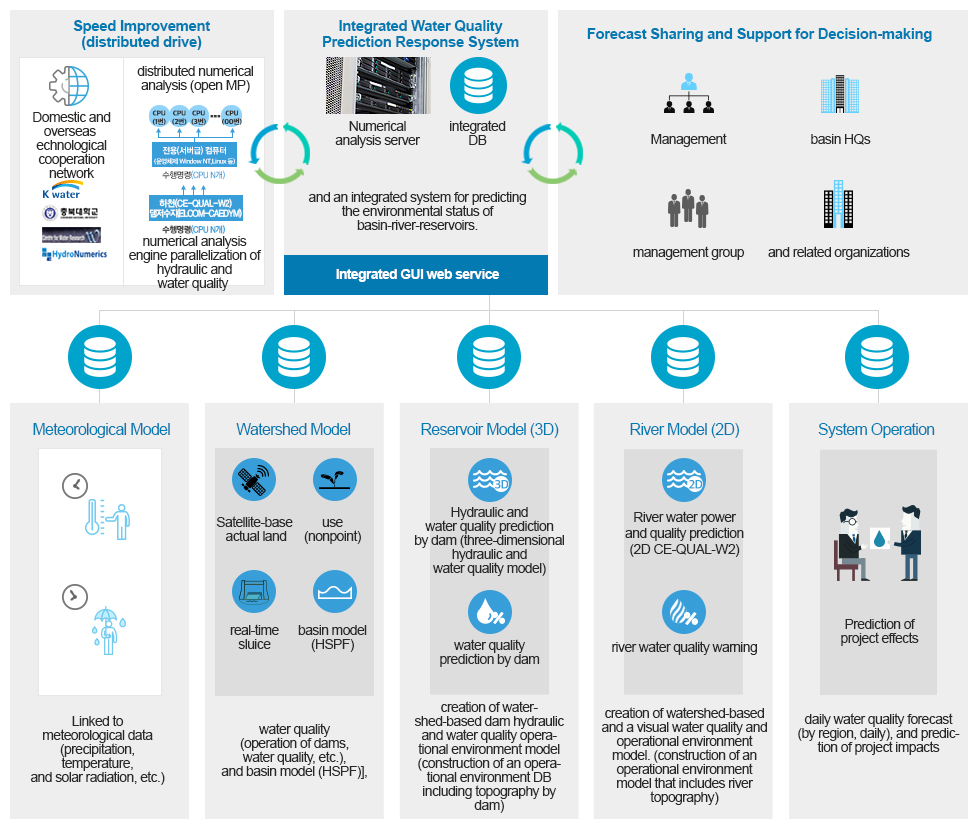
- Speed Improvement (distributed drive): Domestic and overseas technological cooperation network, distributed numerical analysis (open MP), numerical analysis engine parallelization of hydraulic and water quality
- Integrated Water Quality Prediction Response System: Numerical analysis server, integrated DB, and an integrated system for predicting the environmental status of basin-river-reservoirs.
- Forecast Sharing and Support for Decision-making: Management, basin HQs, management group, and related organizations
- Meteorological Model: Linked to meteorological data (precipitation, temperature, and solar radiation, etc.)
- Watershed Model: [Satellite-based actual land, use (nonpoint), real-time sluice, water quality (operation of dams, water quality, etc.), and basin model (HSPF)],
- Reservoir Model (3D): [Hydraulic and water quality prediction by dam (three-dimensional hydraulic and water quality model), water quality prediction by dam, creation of watershed-based dam hydraulic and water quality operational environment model (construction of an operational environment DB including topography by dam)]
- River Model (2D): [River water power and quality prediction (2D CE-QUAL-W2), river water quality warning], creation of watershed-based and a visual water quality and operational environment model. (construction of an operational environment model that includes river topography)
- System Operation: [Prediction of project effects], daily water quality forecast (by region, daily), and prediction of project impacts
Collection and Treatment of Floating Objects
Background and Basis
- Article 31 of 「the Water Environment Conservation Act」 (Collection and Treatment of Waste in Lakes)
- Article 17 of 「the Act on Construction and Management of Dams and Assistance to Their Environs」 Regulation on Dam Management
Collection and Treatment Status
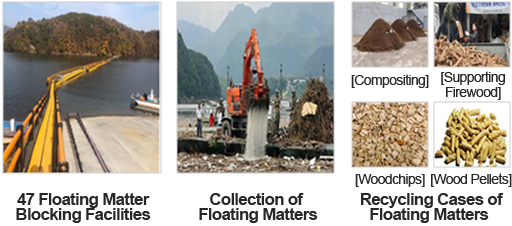
- A large amount of trash around dams and barrage areas flows into the water system during flooding events
- K-water immediately collects the floating matter, classifies them by types, and recycles them according to the due process
Operation of Algal Bloom Reduction Facilities
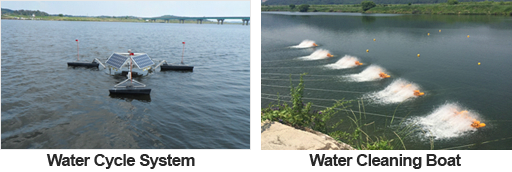
- (Objectives) Introduced a range of facilities to improve water quality and reduce algae in dams and rivers
- (Dams) Operates around 500 pieces of equipment, including water cycle facilities, water cleaning boats, algae barriers, and algae removing boats, etc
- (Barrages) Operates around 100 pieces of equipment, including water cycle facilities, water cleaning boats, algae barriers, and algae removing boats, etc
Management of Basin Pollutants and the Improvement of Upper Stream Environment
Execution of Basin Pollutant Management Measures
- Establish and implement improvement measures for algae and water quality pollution, such as creating artificial wetlands, introducing eco-friendly agriculture methods, and introducing public sewerage facilities to reduce the inflow of pollutants
Technological Development
Satellite-utilized Monitoring
Monitor watershed-based algae distribution based on weekly Chl-a data provided by the European Space Agency

Unmanned Aerial Algae Monitoring
Green Algae Monitoring on extensive zones using unmanned aerial vehicles with multi-spectral cameras
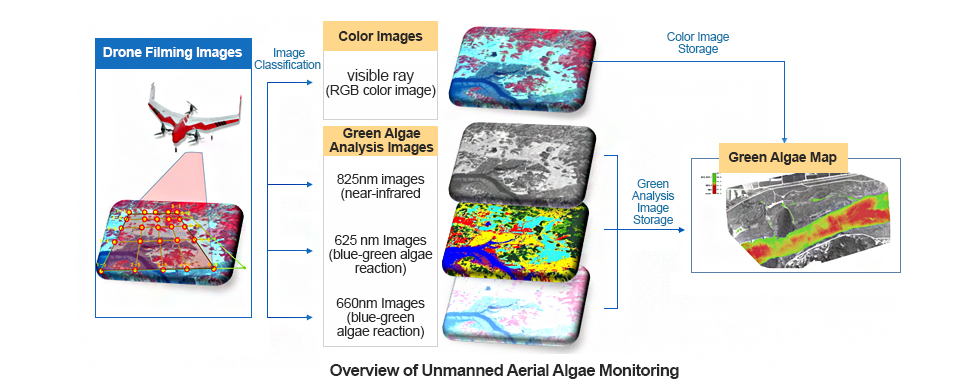
Overview of Unmanned Aerial Algae Monitoring: Drone Filming Images - Image Classification - Color Images (visible ray (RGB color image)), Green Algae Analysis Images (825nm images (near-infrared), 625 nm Images (blue-green algae reaction), 660nm Images (blue-green algae reaction)) - Color Image Storage, Green Analysis Image Storage - Green Algae Map
Unmanned Aerial Green Algae Monitoring Case
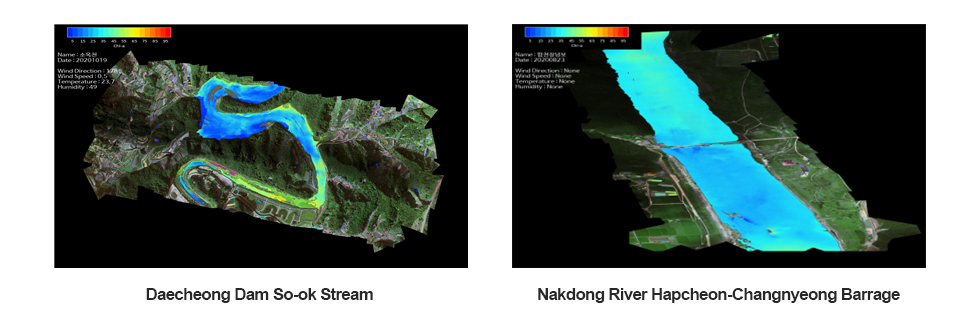
Unmanned Aerial Green Algae Monitoring Case (Daecheong Dam So-ok Stream , Nakdong River Hapcheon-Changnyeong Barrage)
Monitoring of Hazardous Areas Using CCTV
Introducing CCTVs to monitor hazardous green algae areas at all times

CCTV System Configuration: [Dam/Barrage CCTV] ↔ Wireless Network or Ethernet ↔ [Management Group Image Storage Distribution Server] ↔ MSPP ↔ [Internal and External Information System], [Big Board and Mobile], [Related Organizations Including the Ministry of Land, Infrastructure and Transport
Eco Filtering
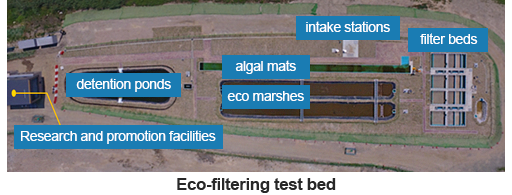
Technological developments to improve water quality in an eco-friendly way using river soil and detention ponds
Responding to Water Pollution Incidents and Algal Blooms
![Responding to Water Pollution Incidents and Algal Blooms [이미지]](/web/eng/images/renew_2019/green_tide_img10_2021.png)
- In an effort to manage and respond to water pollution incidents and green algae issues proactively and preemptively, K-water has established and carried out a green algae response action plan, increased on-site monitoring, and maximized national initial response capabilities through 51 dam and barrage management groups, which are capable of taking immediate action to address water pollution incidents.
- In addition, we have established and are managing substantial measures for water pollution, including the monitoring of green algae and supporting national water pollution reduction measures. Having conducted a variety of research to address green algae issues, the reports and data are freely available on the K-water’s Research Institute website(https://www.kwater.or.kr/kiwe/main.do).